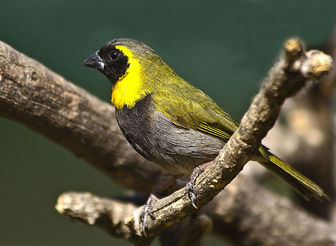Cuban Grassquit
Its natural habitats are subtropical or tropical moist lowland forests, subtropical or tropical moist montane forests, subtropical or tropical dry shrubland, and heavily degraded former forest.

Original source: Richard TaylorPermission(Reusing this file)This image, which was originally posted to Flickr.com, was uploaded to Commons using Flickr upload bot on 12:30, 12 March 2010 (UTC) by Snowmanradio (talk). On that date it was licensed under the license below.This file is licensed under the Creative Commons Attribution 2.0 Generic license.You are free:to share – to copy, distribute and transmit the work
Author: Richard TaylorPermission(Reusing this file)This image, which was originally posted to Flickr.com, was uploaded to Commons using Flickr upload bot on 12:30, 12 March 2010 (UTC) by Snowmanradio (talk). On that date it was licensed under the license below.This file is licensed under the Creative Commons Attribution 2.0 Generic license.You are free:to share – to copy, distribute and transmit the work
The Cuban Grassquit is classified as Least Concern. Does not qualify for a more at risk category. Widespread and abundant taxa are included in this category.
The Cuban Grassquit (Tiaris canorus) is a small bird formerly placed with the Emberizidae. It is now recognized as a tanager closely related to Darwin's finches. It is found in Bahamas, Cuba, and Turks and Caicos Islands. Its natural habitats are subtropical or tropical moist lowland forests, subtropical or tropical moist montane forests, subtropical or tropical dry shrubland, and heavily degraded former forest. References - * BirdLife International 2004. More
* Cuban Grassquit (Tiaris canorus) * Sooty Grassquit (Tiaris fuliginosus) * Dull-coloured Grassquit (Tiaris obscurus) * Yellow-faced Grassquit (Tiaris olivaceus) * Black-faced Grassquit (Tiaris bicolor) Grassquits of other genera - * Yellow-shouldered Grassquit (Loxipasser anoxanthus) * Blue-black Grassquit (Volatinia jacarina) Stub icon This article about a tanager is a stub. More
Cuban Grassquit (Tiaris canora) = * Least Concern * List * Thumbs * All * Videos * Photos * Sounds Videos 6 videos * Video preview image A male foraging on the ground and then perched More
Cuban Grassquit - Tiaris canora = Florida's Nonnative Wildlife. Species detail. First year: 1958 Extirpated year: Established status: Species have populations whose status is unknown. Estimated Florida range: 3 counties Not reported breeding Statewide trend: Unknown status Threats to natives: Unknown Species Account: Native to Cuba, where it inhabits forests, forest edges, and scrub. More
Cuban Grassquit (Tiaris canora) Nassau, New Providence I., Bahamas. January 1999. More
Cuban Grassquit Tiaris canora = * Home Expand Log in Menu item Register Menu item Log out Menu item Change login details Menu item Why register? Expand UK & Ireland Menu item Birding sites More
Stamps showing Cuban Grassquit Tiaris canorus Cuban Grassquit Tiaris canorus Cuban Grassquit Tiaris canorus Cuban Grassquit Tiaris canorus Cuban Grassquit Tiaris canorus Cuban Grassquit Tiaris canorus Cuban Grassquit Tiaris canorus Bargain of the day! Cuban Grassquit Links will open countrypage in new window - Antigua & Barbuda 17.04.2000 Stamp Show 2000 - Cuba 01.12. More
The Cuban Grassquit is a species of finch. It is common across the Cuba and the Isle of Youth. Pugnacious, especially hostile while breeding, and especially so towards birds of the same species or with black and/or yellow plumage. More
hippocrepis), Cuban Grassquit, White warblers, Great Lizard-Cuckoo. Day 4 Breakfast. Birding session in Mil Cumbres natural zone. Lunch in the field. Return to the El Mirador Hotel. Dinner at the hotel. *Possible species for viewing are: the endemic Cuban Solitaire, Red-legged Honeycreepers, the spectacular Red-legged Thrush, the Cuban Trogo (National Bird), Loggerhead Kingbirds, and (3) more endemics: Yellow-headed Warbler, Cuban Tody and Cuban Bullfinch. More
Cuban Grassquit Tiaris canora = New Providence Island, The Bahamas - Jan, 1999 More
Cuban Grassquit Tiaris canora = Described by: Gmelin (1789) Alternate common name(s): Melodious Grassquit Old scientific name(s): None known by website authors Photographs New Providence Island, The Bahamas - Jan, 1999 More
Cuban Grassquit - Tiaris canorus Sporophile petit-chanteur = Sporophile petit-chanteur Le guide ornitho : Les 848 espèces d'Europe en 4000 dessins Gallery : © William Frohawk Site web : antiqueprints.com Order : Passériformes Family : Thraupidae Species : Cuban Grassquit Reference: wifr13134 Copy forbidden without prior authorization. More
Cuban Grassquit has declined drastically in the west and centre of the main island due to trapping for the cagebird trade. Ten years ago the species could still be found locally in the Zapata region, but this grassquit is now extirpated in that region. Further east on Cuba it is still a common bird, even in the desertic environment of the extreme south-east. Elsewhere a population was accidentally introduced onto one of the Bahamas, which population has increased. More
Cuban Grassquit, Tiaris canora Emberizidae (BUNTINGS, SEEDEATERS & ALLIES) Cuban Grassquit, Tiaris canora This photo was taken in: Cuba The photo was taken by: Steve Bird , Birdseekers Cuba report An excellent tour in which all the Cuban specialities that were possible, were seen! Birdseekers Tour reports Birdwatching Holidays around the world Birdseekers photo's taken by Tony Crittenden More
Family : Emberizidae
Genus : Tiaris
Species : canorus
Authority : (Gmelin, 1789)
